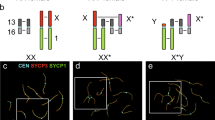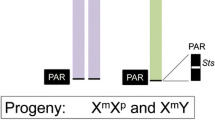Abstract
In the mouse XYY males are sterile, presumably because pairing abnormalities resulting from the presence of three sex chromosomes lead to meiotic breakdown. We have produced male mice, designated XYY*X, that have three sex chromosome pairing regions but only one intact Y chromosome. Unexpectedly XYY*X males are fertile, although they are no more efficient in sex chromosome pairing than previously reported XYY males. We conclude that the sterility of XYY males is caused by a combination of the deleterious effect of two Y chromosomes, presumably acting prior to meiosis, and pairing abnormalities resulting in significant meiotic disruption.
Similar content being viewed by others
References
Benet J, Martin RH (1988) Sperm chromosome complements in a 47, XYY man. Hum Genet 78: 313–315
Bond DJ, Chandley AC (1983) Aneuploidy. Oxford monographs on medical genetics, no. 11. Oxford University Press
Burgoyne PS (1979) Evidence for an association between univalent Y chromosomes and spermatocyte loss in XYY mice and men. Cytogenet Cell Genet 23: 84–89
Burgoyne PS, Biddle FG (1980) Spermatocyte loss in XYY mice. Cytogenet Cell Genet 28: 143–144
Cattanach BM, Pollard CE (1969) An XYY sex-chromosome constitution in the mouse. Cytogenetics 8: 80–86
Das RK, Behera AK (1984) A 39, X/40, XY/41, XYY mosaic male mouse. Cytogenet Cell Genet 38: 138–141
Das RK, Kar RN (1981) A 41, XYY mouse. Experientia 37: 821–822
Davisson MT, Akeson EC (1987) An improved method for preparing G-banded chromosomes from mouse peripheral blood. Cytogenet Cell Genet 45: 70–74
De Boer P (1986) Chromosomal causes for fertility reduction in mammals. In: Serres FJ (ed) Chemical mutagens, vol 10. Plenum Press, New York, pp 427–467
Eicher EM (1982) Primary sex determining genes in mice. In: Amann RP, Seidel GE (eds) Prospects for sexing mammalian sperm. Colorado Assoc Univ Press, Boulder, pp 121–138
Eicher EM, Washburn LL (1978) Assignment of genes to regions of mouse chromosomes. Proc Natl Acad Sci USA 75: 946–950
Eicher EM, Hale DW, Hunt PA, Lee BK, Tucker PK, King TR, Eppig JT, Washburn LL The mouse Y* chromosome involves a complex rearrangement including interstitial positioning of the pseudoautosomal region (submitted)
Evans EP, Breckon G, Ford CE (1964) An air-drying method for meiotic preparations from mammalian testes. Cytogenetics 3: 289–294
Evans EP, Ford CE, Searle AG (1969) A 39 XO/41 XYY mosaic mouse. Cytogenetics 8: 87–96
Evans EP, Ford CE, Chaganti RSK, Blank CE, Hunter H (1970) XY spermatocytes in an XYY male. Lancet i: 719
Evans EP, Beechey CV, Burtenshaw MD (1978) Meiosis and fertility in XYY mice. Cytogenet Cell Genet 20: 249–263
Foster HL, Small JD, Fox JG (eds) (1983) The mouse in biomedical research. Academic Press, New York, p 424
Hunt PA Survival of XO mouse fetuses: Effect of parental origin of the X chromosome or uterine environment? Development (in press)
Levy ER, Burgoyne PS (1986) The fate of XO germ cells in the testes of XO/XY and XO/XY/XYY mouse mosaics: evidence for a spermatogenesis gene on the mouse Y chromosome. Cytogenet Cell Genet 42: 208–213
Lovell-Badge R, Robertson E (1990) XY female mice resulting from a heritable mutation in the primary testis-determining gene, Tdy. Development 109: 635–646
Oakberg EF (1956) A description of spermiogenesis in the mouse and its use in analysis of the cycle of the seminiferous spithelium and germ cell renewal. Am J Anat 99: 391–413
Palmer SJ, Mahadevaiah SK, Burgoyne PS (1990) XYY spermatogenesis in XO/XY/XYY mosaic mice. Cytogenet Cell Genet 54: 29–34
Rathenberg R, Muller D (1973) X and Y chromosome pairing and disjunction in a male mouse with an XYY sex-chromosome constitution. Cytogenet Cell Genet 12: 87–92
Skakkebaek NE, Zeuthen E, Nielsen J, Yde H (1973) Abnormal spermatogenesis in XYY males: a report on cases ascertained through a population study. Fertil Steril 24: 290–395
Author information
Authors and Affiliations
Additional information
by P.B. Moens
Rights and permissions
About this article
Cite this article
Hunt, P.A., Eicher, E.M. Fertile male mice with three sex chromosomes: Evidence that infertility in XYY male mice is an effect of two Y chromosomes. Chromosoma 100, 293–299 (1991). https://doi.org/10.1007/BF00360527
Received:
Accepted:
Issue Date:
DOI: https://doi.org/10.1007/BF00360527




